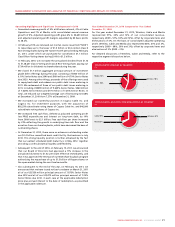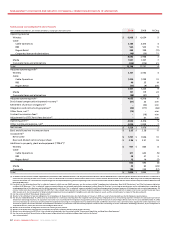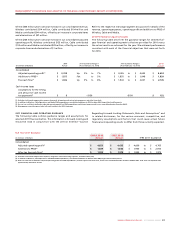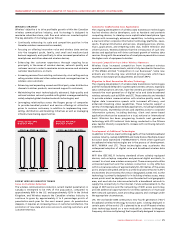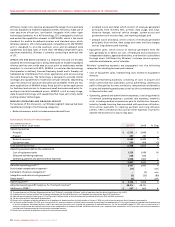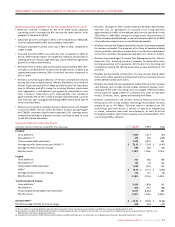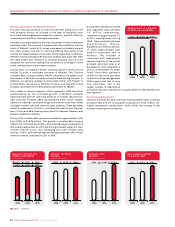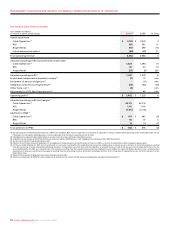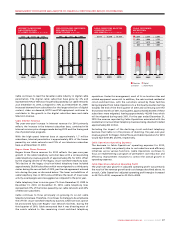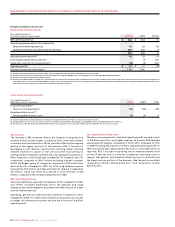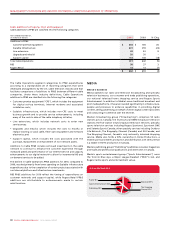Rogers 2010 Annual Report Download - page 27
Download and view the complete annual report
Please find page 27 of the 2010 Rogers annual report below. You can navigate through the pages in the report by either clicking on the pages listed below, or by using the keyword search tool below to find specific information within the annual report.
ROGERS COMMUNICATIONS INC. 2010 ANNUAL REPORT 31
MANAGEMENT’S DISCUSSION AND ANALYSIS OF FINANCIAL CONDITION AND RESULTS OF OPERATIONS
Cable’s Products and Services
Cable has highly-clustered and technologically advanced broadband
cable networks in the provinces of Ontario, New Brunswick and
Newfoundland and Labrador. Its Ontario cable systems, which
encompassapproximately90%ofits2.3milliontelevisionsubscribers,
are concentrated in and around three principal clusters: (i) the Greater
Toronto Area, Canada’s largest metropolitan centre; (ii) Ottawa, the
capital city of Canada; and (iii) the Guelph to London corridor in
southwestern Ontario. The New Brunswick and Newfoundland and
Labrador cable systems in Atlantic Canada comprise the balance of its
cable systems and subscribers.
Through its technologically advanced broadband networks, Cable
offers a diverse range of services, including digital and analog cable
television, Internet access and voice-over-cable telephony services.
AsatDecember31,2010,approximately89%ofCable’soverallnetwork
and99%ofitsnetworkinOntariohadbeenupgradedtotransmit860
MHz of bandwidth. With approximately 99% of Cable’s network
offering digital cable services, it has a richly featured and highly
competitive video offering, which includes high-definition television
(“HDTV”), on-demand programming including movies, television series
and events available on a per-purchase basis or in some cases on a
subscription basis, personal video recorders (“PVR”), time-shifted
programming, as well as a significant line-up of digital specialty,
multicultural and sports programming.
During 2009, Cable introduced Rogers On-Demand Online, Canada’s
most comprehensive online destination for primetime and specialty TV
programming, movies, sports and web-only extras. The service is
offered as strong added value to all Rogers Customers across Canada,
with Cable customers getting additional access to specialty content
based on their cable package. In the fall of 2010, a transactional section
was added to service, allowing users to rent and stream new releases
and library titles online. The service is currently accessible through
laptops and desktops, with plans to extend access to other devices in
the near future.
Cable offers multiple tiers of Internet services, which are differentiated
principally by bandwidth capabilities and monthly usage allowances.
Cable’s voice-over-cable telephony services were introduced in July
2005 and have grown both in the number of subscribers and in the size
of the geographic area where the service is available. Cable offers a
variety of home phone packages coupled with competitive feature sets
and long-distance plans.
Cable offers multi-product bundles at discounted rates, which allow
customers to choose from among a range of Rogers’ cable television,
Internet, voice-over-cable telephony and wireless products
and services, subject to, in most cases, minimum purchase and
term commitments.
Cable’s RBS segment offers local and long-distance services, enhanced
voice and data networking services, and IP application solutions to
businesses, government agencies and telecom wholesalers in many
markets across Canada on both an on-net and resold basis. Cable
has increasingly refocused its marketing and sales to concentrate on
offerings that utilize its own facilities within its traditional cable
television serving areas.
Cable sells and services Rogers branded Cable and Wireless products
and also offers DVD and video game sales and rentals through
Rogers Retail.
Cable’s Distribution
In addition to the Rogers Retail stores, Cable markets its services
through an extensive network of third party retail locations across its
network footprint. Rogers Retail provides customers with a single
direct retail channel featuring Rogers’ wireless and cable products and
services. In addition to its own and third party retail locations, Cable
markets its services and products through a variety of additional
channels, including call centres, outbound telemarketing, field agents,
direct mail, television advertising, its own direct sales force, exclusive
and non-exclusive agents, as well as through business associations.
Cable also offers products and services and customer service via our
e-business website, rogers.com.
Cable’s Networks
Cable’s networks in the provinces of Ontario, New Brunswick, and
Newfoundland and Labrador, with few exceptions, are interconnected
to regional head-ends, where analog and digital channel line-ups are
assembled for distribution to customers and Internet traffic is
aggregated and routed to and from customers, by inter-city fibre-optic
rings. The fibre-optic interconnections allow the majority of its cable
systems to function as a single cable network. Cable’s two regional
head-ends in Toronto, Ontario and Moncton, New Brunswick provide
the source for most television signals used across its cable systems.
Cable’s technology architecture is based on a three-tiered structure of
primary hubs, optical nodes and co-axial distribution. The primary
hubs, located in each service region, are connected by an inter-city
fibre-optic network carrying television, Internet, network control and
monitoring and administrative traffic. The fibre-optic network is
generally configured in rings that allow signals to flow in and out of
each primary hub, or head-end, through two paths, providing
protection from a fibre cut or other disruption. These high-capacity
fibre-optic networks deliver high performance and reliability and
generally have capacity for future growth in the form of dark fibres and
unusedopticalwavelengths.Approximately99%ofthehomespassed
by Cable’s network are fed from primary hubs, or head-ends, which
serveonaverage90,000homeseach.Theremaining1%ofthehomes
passed by the network are in smaller more rural systems mostly in New
Brunswick and Newfoundland and Labrador that are served by smaller
non-fibre connected hubs.
Optical fibre joins the primary hub to the optical nodes in the
cable distribution plant. Final distribution to subscriber homes from
optical nodes uses high-bandwidth co-axial cable with two-way
amplifiers to support on-demand television and Internet service.
Co-axial cable capacity has been increased repeatedly by introducing
more advanced amplifier technologies. Co-axial cable is a cost-
effective, high-bandwidth and widely deployed means of carrying
two-way digital television, broadband Internet and telephony services
to residential subscribers.
Groups of on average 430 homes are served from each optical node in a
cable architecture commonly referred to as fibre-to-the-feeder
(“FTTF”). The FTTF plant provides bandwidth generally at 860 MHz,
which includes 37 MHz of bandwidth used for “upstream” transmission
from the subscribers’ premises to the primary hub. As additional
downstream and/or upstream capacity is required, the number of
homes served by each optical node is reduced in an engineering
practice referred to as node-splitting. Fibre cable has been placed to
permit a continuous reduction of the average node size by installing
additional optical transceiver modules and optical transmitters and
return receivers in the head-ends and primary hubs.
Business Solutions 14%
Television 45%
Home Phone 12%
Internet 21%
Retail 8%
CABLE REVENUE MIX


